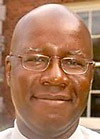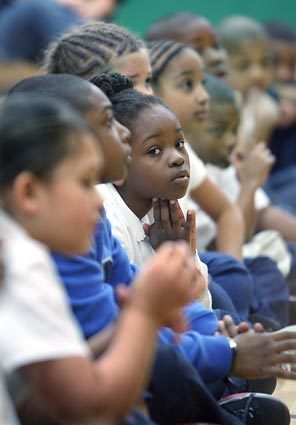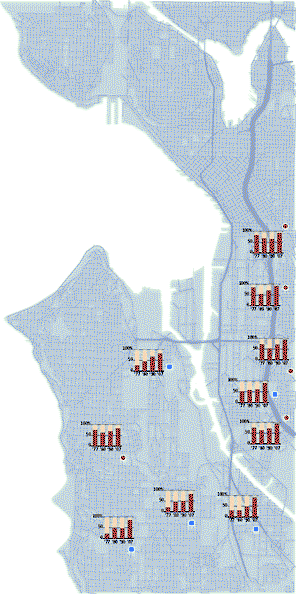Originally published Sunday, June 1, 2008 at 12:00 AM
The resegregation of Seattle's schools
Nearly three decades after Seattle Public Schools integrated almost all its schools through busing, that racial balance is long gone. Leschi Elementary, about evenly...
Seattle Times education reporter
STEVE RINGMAN / THE SEATTLE TIMES
Leschi Elementary is an example of the racial divide in Seattle schools. Those divides are largely the byproduct of housing patterns. Leschi Elementary is 94 percent nonwhite. Loyal Heights, at the other end of the spectrum, is 85 percent white.
TOM REESE / THE SEATTLE TIMES
Loyal Heights is an example of the racial divide in Seattle schools. Those divides are largely the byproduct of housing patterns. Leschi Elementary is 94 percent nonwhite. Loyal Heights, at the other end of the spectrum, is 85 percent white.

"We like to think of ourselves as these enlightened, liberal folks. But the fact is our schools aren't the way that people really think they are." — Harium Martin-Morris

"The hard truth is that the school district is hard-pressed to single-handedly overturn segregated housing patterns in the city." — Steve Sundquist
Nearly three decades after Seattle Public Schools integrated almost all its schools through busing, that racial balance is long gone.
Leschi Elementary, about evenly divided between white and minority students in 1980, has a nearly all-minority population once again. The same is true for Brighton Elementary, Dunlap Elementary, Van Asselt Elementary — and all but two of the 26 schools that, the year before busing started, were considered racially imbalanced. Today, a total of 30 schools — close to a third of the district's buildings — have nonwhite populations that far exceed the district's average of 58 percent. In 20 of them, nonwhite enrollment is 90 percent or more.
Seattle schools don't look exactly like they did before districtwide busing began in 1978. There are fewer nearly all-white schools. Minority students are not as concentrated as they once were in the central part of the city.
But Seattle Public Schools, like many districts across the nation, has slowly, steadily resegregated.
"We like to think of ourselves as these enlightened, liberal folks," says School Board member Harium Martin-Morris. "But the fact is our schools aren't the way that people really think they are."
The segregation is often the byproduct of who lives where. But other schools end up that way through the choices parents make.
The Seattle School Board is weighing what, if anything, to do about the situation. As the board plans a major overhaul of how it assigns students to schools, its members face conflicting desires.
Do they assign more students to schools close to their homes? That's what many parents say they want, and it's what the board (before last year's elections) voted to pursue.
Do they try to ensure racial diversity at every school? Many parents say they want that, too. But if a neighborhood is segregated, Martin-Morris points out, a neighborhood school will be, too.
The board is more limited than ever in what it can do, especially after the U.S. Supreme Court's closely watched desegregation decision a year ago. The court ruled that Seattle and Jefferson County Public Schools in Kentucky could no longer use a student's race in deciding where some students attend school.
Seattle School Board members may face pressure to do something. If they don't, said James Kelly, president and CEO of the Urban League of Metropolitan Seattle, he'll recommend that the league's board of directors take legal action.
Segregated schools have never been equal, Kelly said, largely because high-minority schools are often high-poverty schools.
![]()
He favors allowing parents a wide choice of schools. He knows that's expensive, he says, but "we can't afford a segregated, unequal system either."
Busing worked on paper
Seattle never had the kind of laws that, in places such as Little Rock, Ark., forbade white and minority students from going to school together.
But Seattle did have housing covenants and other discriminatory practices that limited minority families to certain neighborhoods. The school segregation that those practices caused was what the district's busing plan, adopted in 1977, was designed to change. The district turned to busing after more than a decade of other efforts, including a voluntary transfer program that, at its peak in 1969-70, attracted just 3 percent of district students.
Mandatory busing involved about 12,000 of the district's 54,000 students. Three years after it started, the district reached its racial-enrollment goals.
By 1980, only one school — Cleveland High — still was considered "racially imbalanced" because its minority population was 20 percentage points or more above the district average.
But mandatory busing didn't create as much diversity as the numbers might appear to show. White enrollment dropped by 28 percent in the first three years of busing, with many students moving to the suburbs or private schools, according to a district history of its desegregation efforts. (Minority enrollment over the same period went up about 10 percent.)
More minority than white students ended up riding buses, despite careful planning to avoid that. And too many schools, integrated on paper, were still segregated in the lunchroom, and sometimes even the classroom.
Busing did not achieve one of its main goals, which was to raise academic achievement, said Dorothy Woods, who spent decades as a teacher, principal and instructional coach in Seattle schools.
It did not improve relationships between teachers and students, she said, or rigor, or instruction.
As the district reduced busing in 1989, then ended it entirely eight years later, the racial balance at many schools continued to unravel.
From 1970 to today, the district's enrollment dropped from 85,000 students to 45,000. The nonwhite enrollment nearly tripled, and is now 58 percent. The city's population, over the same time period, grew 8 percent, and its minority population more than doubled.
A year ago, the U.S. Supreme Court threw out the last, modest policy that Seattle used to increase diversity. Called the racial tiebreaker, it gave preference to students who would improve the racial balance at popular, racially imbalanced schools.
When last in use, it involved only about 10 percent of the district's 3,000 incoming freshmen.
The court's decision made it clear that school districts can't discriminate based on race when placing students in schools. (The ruling covered voluntary desegregation efforts, not court-ordered plans still in place in a few hundred districts.)
The court said that diversity in the nation's public schools also is important. Justice Anthony Kennedy suggested other ways to accomplish it. Some districts now are looking at basing some school assignments on family income.
That's something the Seattle School Board is considering, although not to a large degree.
"The hard truth," says School Board member Steve Sundquist, "is that the school district is hard-pressed to single-handedly overturn segregated housing patterns in the city."
Split is economic as well as racial
Today, black and Asian-American students each make up 22 percent of the mix in Seattle. The Latino population — at 12 percent — is growing the fastest, and there's one school — Concord in West Seattle — where the majority of students are Latino. Native Americans make up 2 percent.
About 60 percent of the district's schools have a mix of three or more ethnic groups in significant numbers, something that sets Seattle apart from cities where the racial divide is between black and white or Latino and white.
Different areas of the city, however, vary widely from the districtwide averages.
In the southeast, for example, 93 percent of the public-school, elementary-age students who live there are nonwhite. In Queen Anne and Magnolia, it's 27 percent.
In the north end as a whole (plus Queen Anne and Magnolia), minorities make up 40 percent of public-school students. In the south, they comprise 72 percent.
Parents Involved in Community Schools, the group that filed the lawsuit against the racial tiebreaker, argued in court that Seattle no longer needed the racial tiebreaker because the city's high schools already are racially diverse. The group looked at data from 2000-01, when only one high school — Rainier Beach — had a student body that was less than 10 percent white.
The picture has changed since then. Three high schools — Rainier Beach, Cleveland and Franklin — now have white populations under 10 percent. At the elementary level, some schools have just a handful of white kids, or just a few minority ones.
Wing Luke Elementary, for example, counted four white children among its 322 students last fall. At Dunlap, there are seven. At Loyal Heights Elementary in Northwest Seattle, there are 10 black students, 17 Asian-Americans, 27 Latinos, two Native Americans — and 323 whites.
The city's north-south split is economic as well as racial.
In the north, there is just one elementary school where three-quarters of students qualify for free or low-cost lunches. In the south, there are 14.
Housing and income patterns, however, don't explain everything about the racial mix in Seattle schools.
In one case, the district created a school designed for one ethnic group, the African American Academy. Parents and community leaders pushed to open that school as a place that would nurture African-American students and teach them about African-American culture and history.
But in other schools, the reasons for the racial mix aren't as clear.
Seattle has five elementary schools, for example, where the percentage of nonwhite students is far greater than the percentage of nonwhite students who live in the surrounding neighborhood.
"We say we want diversity, but it's not necessarily what we look for when we're looking for schools," says LaKesha Kimbrough, a black parent whose child used to attend John Muir Elementary (and now is home-schooled).
Challenge: foster, not mandate, diversity
Many stress the social benefits of diverse schools. In its brief to the U.S. Supreme Court, the American Education Research Association said studies clearly show that diverse schools contribute to improved cross-racial understanding, a reduction in prejudice and a willingness to live and work in diverse settings.
It also said that diverse schools lead to higher academic achievement, but Seattle schools ended busing in part because it found no evidence of that.
David Fukuhara, who went to Franklin High when it was equal parts white, black and Asian, says he's watched the diversity of Seattle schools decline as his children have grown, and he thinks they're missing something because of it.
Still, he wouldn't want his children on long bus rides every day. No one suggests that's the solution.
Gary Ikeda, Seattle Public Schools' general counsel, says busing "crippled us and diverted us from pursuing quality education."
"Was it the right answer?" he asks. "Yes, in 1972." But in 2008, he said, "it's clear under the law that mandatory assignments based on race are not appropriate."
The challenge now, he says, is to foster diversity without mandating it.
Seattle's history shows that's no easy task.
Linda Shaw: 206-464-2359 or lshaw@seattletimes.com
Seattle Times staff reporter Justin Mayo and staff researcher Gene Balk contributed to this story.
Copyright © 2008 The Seattle Times Company
UPDATE - 10:51 PM
Seattle Public Schools name interim financial officer
Jerry Large: It's time to change Seattle schools superintendent's job
OMG! Text lingo appearing in schoolwork
STEM grants help attract more students to sciences
Former Seattle schools attorney reverses course, offers to talk with scandal investigator

general classifieds
Garage & estate salesFurniture & home furnishings
Electronics
just listed
More listings
POST A FREE LISTING






